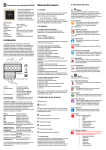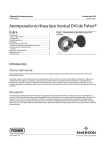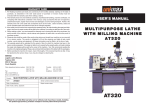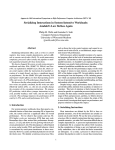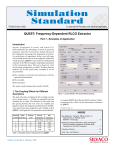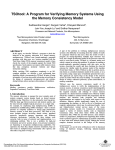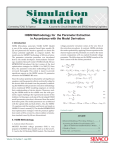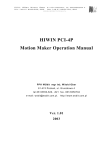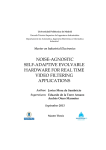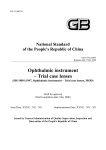Download eleon3lp
Transcript
Enhanced LEON3 Low Power IP Core for DSM Technologies Krzysztof Marcinek, Arkadiusz W. Luczyk and Witold A. Pleskacz Institute of Microelectronics and Optoelectronics Warsaw University of Technology ul. Koszykowa 75, 00-662 Warsaw, Poland [email protected], [email protected], [email protected] Abstract—Power consumption is one of the most important factor in a modern embedded System-on-Chip's (SoC's) design. Increasing computation complexity and incessant growth of clock frequency reveals the necessity for dynamic and smart utilization of the available hardware resources. The paper presents Enhanced LEON3 Low Power IP Core with superscalar abilities and Low Power Management Unit (LPMU). In comparison with the original LEON3 IP core, the new one may execute up to two instructions per cycle and dynamically manage incorporated power domains. Enhanced LEON3LP IP core was synthesized using TSMC 90 nm CMOS technology. Index Terms—DSM, LEON3, power management, low-power, superscalar, microprocessor I. INTRODUCTION Power consumption in SoC Integrated Circuits (ICs) can be divided into two categories. The first one is the dynamic power consumption caused by performing useful operations and it is proportional to the number of transistor state changes per second. The second one is the static power consumption, which is the result of the sub-threshold leakage current and it is dissipated even if the device is not working. Although in the past days static power could be ignored, in today’s deep sub-micron (DSM) technologies it plays a significant role in the total power consumption. Therefore, it is essential to incorporate low-power techniques during the development of modern SoC designs. The easiest way to reduce dynamic power is to decrease the clock frequency. However, clock frequency defines system performance, so nowadays it cannot be taken under consideration in many applications. Superscalar processing [1] allows us to take the advantage of reducing clock frequency without affecting the performance. A typical superscalar processor performs more than one instruction during the same clock cycle, which means faster program execution and minor demands for operating frequency. Although more complex computation means extended hardware resources, additional Funcional Units (FU's) have less impact on the occupied area and the power consumption then a multi-core approach. Studies in superscalar processors [2] show that for a significant amount of time particular FU's remain idle consuming static power. Power gating [3] is one of the most commonly used low-power technique in order to avoid this power loss. While cutting of power supply of the unused FU, source of all parasitic currents is removed. Enhanced LEON3 Low Power IP Core extends well-known open-source LEON3 IP core processor [4] with superscalar abilities and power control feature. LEON3 is available in form of a synthesizable VHDL model based on SPARC V8 [5] instruction set architecture (ISA). The other benefit of using LEON3 is the availability of the TSIM simulator [6] and the BCC cross-compiler [7], which are essential to perform a comparative analysis between the original and the enhanced IP core. The paper is organized as follows. The microarchitecture of LEON3 processor IP core is briefly presented in Section II. Section III describes Enhanced LEON3 Low Power IP core. The paper ends with synthesis results and conclusion. Fig. 1. LEON3 core block diagram II. LEON3 PROCESSOR MICROARCHITECTURE LEON3 processor system allows the user to customize it for certain application due to its configuration abilities. The system is based on LEON3 core connected through AMBA bus [8] to system peripherals. For the use of this work the core was configured to incorporate separated data and instruction cache controllers with AMBA bus interface, interrupt port and hardware, divide and multiply unit (Fig. 1). The register file is a 3-port memory with separated write port and two read ports. It contains general purpose global registers and register windows in number within the limit of the SPARC V8 standard. The integer unit (IU) datapath is based on a 7-stage pipeline with Harvard architecture. IU may perform arithmetic, logical and shift operations, and its unnecessary parts are removed to reduce occupied area. Data dependency is another issue that is handled in the modified IU. The results from four pipeline stages (execute to writeback) are exchanged between both IU's to feed their arithmetic and logical unit (ALU) when necessary. Field Definitions: [31:3] [2] [1] [0] Fig. 2. Enhanced LEON3LP core block diagram III. : Unused. Read as 0. : DIV Unit Enable. 0 – automatic, 1 – always on : MUL Unit Enable. 0 – automatic, 1 – always on : Secondary IU. 0 – disable, 1 – enable Fig. 3. Power Management Register (%asr20) ENHANCED LEON3 LOW POWER PROCESSOR MICROARCHITECTURE For the research, grlib-gpl-1.0.17-b2710 version of GRLIB was used. To obtain execution of two instructions at the same time and power control a number of modifications in the original source code of LEON3 processor system were taken. The new block diagram of Enhanced Low Power LEON3 (ELEON3LP) is shown in Fig. 2. In order to handle the execution of two instructions at the same time, the register file enables reading of four and writing of two independent data words at the same time. The instruction cache controller enables fetching of two valid consecutive instructions. During cache miss however, the instructions are fetched from an external memory through the AMBA interface. In this case, only the Primary IU has the data to handle and the Secondary IU executes the NOP (no operation) instruction. Superscalar Controller is a stand-alone entity that extends the LEON3 pipeline with an additional Prefetch stage. It is situated between the instruction cache controller and both integer units. After fetching of two consecutive instructions, the Prefetch stage decides whether the instructions can be executed in parallel or one after another. In the first case, the fetched instructions are directed to the appropriate integer unit. In the other case, only the first instruction feeds Primary IU (IU0) pipeline, while the Secondary IU (IU1) remains unused and executing the NOP instruction. The second instruction is fetched again in the following cycle. A detailed explenation of extended pipeline functioning can be found in [9]. Source VHDL code of IU is parameterized and may be either used as Primary IU or Secondary IU. However, only the Primary IU is connected to the instruction cache controller, data cache controller, and it has access to the processor internal registers (SPARC V8 ISA registers: PSR, Y, ...). Therefore, it is the only one, which is capable of performing load, store, jump, call, branch, trap, multiply, divide, and all other operations using SPARC V8 ISA registers. Secondary Fig. 4. Power down/up signals order A. Power Managment Register SPARC V8 [5] provides for up to 31 Ancillary State Registers (ASRs), numbered from 1 to 31. ASRs from 16 to 31 are available for implementation-dependent use and can be read or written using RDASR and WRASR assembly instructions [10]. Originally, LEON3 (ELEON3 as well) uses ASRs from 24 to 31, to implement hardware breakpoints, and ASR17 as a processor configuration register. Moreover, writing a value of zero to ASR19 makes the processor to enter “power-down” mode (which holds the pipeline). The Low Power version of ELEON3 processor implements an ASR20 register named Power Management Register (PMR) (Fig. 3). It is used by Low Power Management Unit (LPMU) in order to control power state of ELEON3 power domains. B. Low Power Management Unit The LPMU (Fig. 2) can control up to four separate power domains and its main task is to generate sequence of power down and power up signals [11]. If power back up in a known good state is required, then the save signal holds content of internal registers. Otherwise, the first step to power down the unused block is to isolate it from the remaining parts. Afterwards, the power is removed and the sequence of powering down is finished. The reverse order of these signals are needed to generate power up sequence. Firstly, the power Fig. 7. Primary IU power down/up Fig. 5. Processor configuration menu Fig. 8. Secondary IU power down Fig. 9. Secondary IU power up Fig. 6. LPMU configuration menu is turned on and register content is restored. After that, removing the isolate signal brings complete functionality of once powered off module (Fig. 4). The LPMU can be enabled in ELEON3LP processor system by entering the 'Low-power Management Unit' in processor configuration menu (Fig. 5). LPMU configuration menu enables to define the pulse width in clock cycles of save and restore signals, which are necessary to provide state retention (TSR – SAVE/RESTORE pulse width in Fig. 4). The other parameter is TIS (ISOLATE/SHUTOFF delay time), which defines the number of clock cycle delay between particular phases of power down and power up sequence (Fig. 6). As divide instructions are much more uncommon then the multiply ones, due to their very long execution time, it was decided to place DIV Unit and MUL Unit in the individual power domains. Such step allows to control them separately and turn them on only when necessary. The next power domain is occupied by the Secondary IU to minimize processor power consumption while executing non-optimized Fig. 10. Automatic MUL/DIV power up/down Fig. 11. MUL/DIV power down and hard to parallelize programs. The forth LPMU output interface is used to retain the state of Primary IU, Superscalar Controller and Data and Instruction Cache Controllers. When the processor enters power-down mode, the LPMU starts the sequence of turning off the all controlled domains, bringing the power consumption to the minimum. Due to the state retention of the Primary IU, after being woken up by LPMU because of incoming interrupt, the processor can restore its state, handle the interrupt and continue executing the program (Fig. 7). TABLE I. POWER ESTIMATION Power Domains Dynamic [mW] Total [mW] all on 31.412 31.480 IU1 off @(MUL–on; DIV–on; IU0–on) 26.692 26.748 MUL off @(IU1–off; DIV–on; IU0–on) 19.699 19.744 DIV off @(IU1–off; MUL–off; IU0-on) 17.233 17.273 all off 0.358 0.359 or ASR20[2] will hold these modules powered on the whole time. After switching back to automatic mode, the MUL and DIV Units will be turned off right after timer overflow (Fig. 11). IV. SYNTHESIS RESULTS Mentor Graphics ModelSim software was used as a simulation environment. ELEON3LP processor IP core was synthesized in TSMC 90 nm CMOS technology using Cadence RTL compiler. Table I shows the results of power estimation of the ELEON3LP with a toggle rate – 0.2, probability rate – 0.5 and 3 ns clock period. Processor system’s power domains are successively turning off till the complete shut down. The cache and register file memories were not the subject of the synthesis, so their power consumption was not included in the results. Fig. 12 shows that additional Secondary IU has an insignificant impact on the overall power consumption. Starting from 31.48 mW power consumption of all-power-on system, the LPMU can reduce it to 359 µW powering all the incorporated power domains off. V. Fig. 12. Power estimation diagram When the programmer does not intend to use the Secondary IU, the ARS20[0] should be cleared. In this case Superscalar Controller stops feeding it with new instructions and LPMU powers it down after insuring that its pipeline is empty (Fig. 8). The Superscalar Controller will use again the Secondary IU right after it is turned on and restart after setting bit 0 in the ASR20 (Fig. 9). The value of zero in ASR20[1] or ASR20[2] means that LPMU will automatically power up the DIV or MUL Unit when necessary and power it down while unused for a specific period of time. After detecting a multiplication or division instruction in the pipeline, the appropriate signal indicates the need of turning it on and the timer is started. The processor execution pipeline is being held for the time of complete powering up of the MUL or DIV Unit delaying their start conditions. This is the only time penalty and performance degradation, because of using automatic LPMU mode. Each multiply or divide instruction appearance resets the appropriate timer. Once powered up, the MUL or DIV Unit will be automatically turned off after not being used for 256 clock cycles (Fig. 10). Writing the value of one in ASR20[1] CONCLUSION Enhanced LEON3LP IP core with ability to execute two instructions in parallel and Low Power Management Unit was presented in the paper. The results of power estimation showed that the additional Secondary IU (IU1) has an insignificant impact of 4.72 mW in comparison with 31.48 mW power consumption of the whole processor core. Existence of the LPMU allows the user to match the power consumption to the requirements of the running software. By using dynamic management of the power domains, the LPMU can adjust the power consumption from 31.48 mW to 17.23 mW for the running processor and drop it to 359 µW during the power-down state. REFERENCES [1] James E. Smith, Gurindar S. Sohi, “The microarchitecture of superscalar processors”, Proceedings of the IEEE, Volume 83, Issue 12, pp. 1609 – 1624, Dec 1995. [2] Zhigang Hu, A. Buyuktosunoglu, V. Srinivasan, V. Zyuban, H. Jacobson, P. Bose, “Microarchitectural techniques for power gating of execution units”, ISLPED 2004, Proceedings of the 2004 International Symposium on Low Power Electronics and Design, Page(s): 32 – 37, Aug. 2004. [3] M. Powell, Se-Hyun Yang, B. Falsafi, K. Roy, T. N. Vijaykumar, “Gated-Vdd: a circuit technique to reduce leakage in deep-submicron cache memories”, ISLPED 2000, Proceedings of the 2000 International Symposium on Low Power Electronics and Design, Page(s): 90 – 95. [4] “GRLIB IP CORE User's Manual”, http://www.gaisler.com/. [5] “The SPARC architecture manual Version 8”, http://www.sparc.org/. [6] “TSIM2 Simulator User's Manual”, http://www.gaisler.com/. [7] “BCC Bare-C Cross-Compiler User's Manual”, http://www.gaisler.com/. [8] “AMBA Specification (Rev. 2.0)”, http://www.arm.com/. [9] K. Marcinek, A. W. Łuczyk, W. A. Pleskacz, “Enhanced LEON3 core for superscalar processing”, DDECS '09, Design and Diagnostics of Electronic Circuits and Systems, 2009, Page(s): 238 – 241, Apr. 2009. [10] “SPARC assembly language reference manual”, http://docs.sun.com/. [11] C. Komar, T. Anderson, J. Church, “Formal validation of low-power designs”, Cadence Design System, http://www.cadence.com/.





